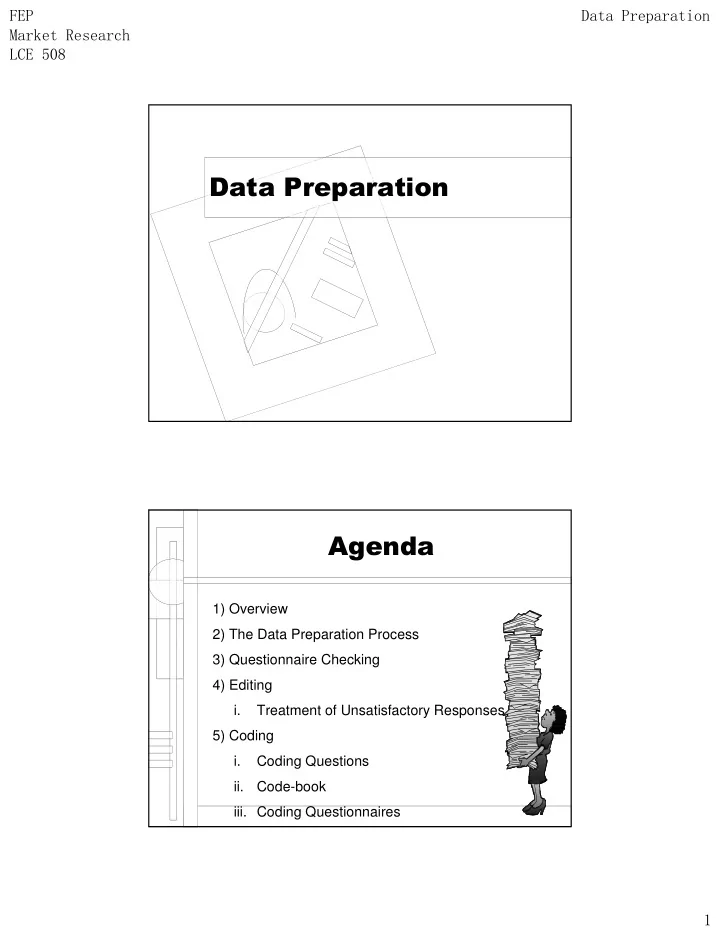

��� ���������������� ��������������� ������� ���������������� ������ 1) Overview 2) The Data Preparation Process 3) Questionnaire Checking 4) Editing i. Treatment of Unsatisfactory Responses 5) Coding i. Coding Questions ii. Code-book iii. Coding Questionnaires �
��� ���������������� ��������������� ������� ������ 6) Transcribing 7) Data Cleaning i. Consistency Checks ��������� ��� ii. Treatment of Missing Responses ���� 8) Statistically Adjusting the Data i. Weighting ii. Variable Respecification iii. Scale Transformation 9) Selecting a Data Analysis Strategy 10) A Classification of Statistical Techniques ������������������������ ����������������������������������������� ������������������� ���� ���� ���������� ���������� ����������������������������� ����������������������������� �
��� ���������������� ��������������� ������� ���������������������� A questionnaire returned from the field may be unacceptable for several reasons. – Parts of the questionnaire may be incomplete. – The pattern of responses may indicate that the respondent did not understand or follow the instructions. – The responses show little variance. – One or more pages are missing. – The questionnaire is received after the preestablished cutoff date. – The questionnaire is answered by someone who does not qualify for participation. ������� Treatment of Unsatisfactory Results – Returning to the Field – The questionnaires with unsatisfactory responses may be returned to the field, where the interviewers recontact the respondents. – Assigning Missing Values – If returning the questionnaires to the field is not feasible, the editor may assign missing values to unsatisfactory responses. – Discarding Unsatisfactory Respondents – In this approach, the respondents with unsatisfactory responses are simply discarded. �
��� ���������������� ��������������� ������� ������ Coding means assigning a code, usually a number, to each possible response to each question. The code includes an indication of the column position (field) and data record it will occupy. Coding Questions • Fixed field codes , which mean that the number of records for each respondent is the same and the same data appear in the same column(s) for all respondents, are highly desirable. • If possible, standard codes should be used for missing data. Coding of structured questions is relatively simple, since the response options are predetermined. • In questions that permit a large number of responses, each possible response option should be assigned a separate column. ������ Guidelines for coding unstructured questions: • Category codes should be mutually exclusive and collectively exhaustive. • Only a few (10% or less) of the responses should fall into the “other” category. • Category codes should be assigned for critical issues even if no one has mentioned them. • Data should be coded to retain as much detail as possible. �
��� ���������������� ��������������� ������� �������� A codebook contains coding instructions and the necessary information about variables in the data set. A codebook generally contains the following information: • column number • record number • variable number • variable name • question number • instructions for coding ��������������������� • The respondent code and the record number appear on each record in the data. • The first record contains the additional codes: project code, interviewer code, date and time codes, and validation code. • It is a good practice to insert blanks between parts. �
��� ���������������� ��������������� ������� ������������� ������������������ Consistency checks identify data that are out of range, logically inconsistent, or have extreme values. – Computer packages like SPSS, SAS, EXCEL and MINITAB can be programmed to identify out-of- range values for each variable and print out the respondent code, variable code, variable name, record number, column number, and out-of-range value. – Extreme values should be closely examined. ������������� ��������������������� ��������� • Substitute a Neutral Value – A neutral value, typically the mean response to the variable, is substituted for the missing responses. • Substitute an Imputed Response – The respondents' pattern of responses to other questions are used to impute or calculate a suitable response to the missing questions. • In casewise deletion , cases, or respondents, with any missing responses are discarded from the analysis. • In pairwise deletion , instead of discarding all cases with any missing values, the researcher uses only the cases or respondents with complete responses for each calculation. �
��� ���������������� ��������������� ������� ���������������������������� ���� ��������� • In weighting , each case or respondent in the database is assigned a weight to reflect its importance relative to other cases or respondents. • Weighting is most widely used to make the sample data more representative of a target population on specific characteristics. • Yet another use of weighting is to adjust the sample so that greater importance is attached to respondents with certain characteristics. ���������� ����!������� �������� Use of Weighting for Representativeness Years of Sample Population Education Percentage Percentage Weight Elementary School 0 to 7 years 2.49 4.23 1.70 8 years 1.26 2.19 1.74 High School 1 to 3 years 6.39 8.65 1.35 4 years 25.39 29.24 1.15 College 1 to 3 years 22.33 29.42 1.32 4 years 15.02 12.01 0.80 5 to 6 years 14.94 7.36 0.49 7 years or more 12.18 6.90 0.57 Totals 100.00 100.00 �
��� ���������������� ��������������� ������� ���������������������������� ���� "����� ����������������� • Variable respecification involves the transformation of data to create new variables or modify existing variables. • E.G., the researcher may create new variables that are composites of several other variables. • Dummy variables are used for respecifying categorical variables. The general rule is that to respecify a categorical variable with K categories, K -1 dummy variables are needed. �� �������������� ��� ������������� ��������������� !�"!�#�$%��������&���������'��������������� (��)����������������������������� ��������������������������������*��� +��������������������������������'��������� ���������������������� �
Recommend
More recommend